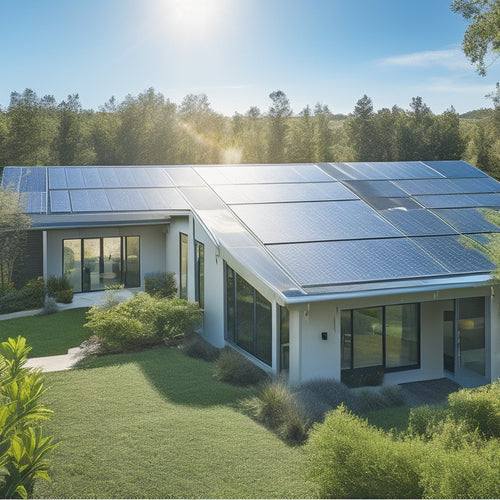
Solar Battery Bank Cost
Share
As you consider investing in a solar battery bank, you're likely wondering about the cost. The upfront investment varies depending on the type of energy storage solution you choose, with lithium-ion batteries being the most expensive upfront, but offering longer lifespans and higher energy density. Lead-acid batteries, on the other hand, are more cost-effective initially, but have shorter lifespans and heavier weights. Nickel-cadmium and flow/gel batteries offer unique benefits, but come with their own set of drawbacks. Understanding the pros and cons of each option is essential for making an informed decision that meets your specific needs and budget; now, let's break down the factors that impact your overall investment.
The Essentials
- The upfront cost of a solar battery bank varies depending on the type and quality of batteries, with lithium-ion batteries being the most expensive.
- Government incentives and tax credits can help reduce the overall cost of a solar battery bank, making it a more affordable option.
- The cost of a solar battery bank is influenced by its capacity, with larger banks requiring more batteries and increasing the overall cost.
- Energy storage systems can provide long-term energy savings, reducing peak-hour energy consumption and alleviating costs associated with grid reliance.
- The total cost of a solar battery bank includes not only the initial investment but also maintenance and replacement costs over its lifespan.
Reliable Renewable Energy Source
You're likely considering a reliable renewable energy source to reduce your carbon footprint and energy costs.
To accomplish this, you'll need energy storage solutions that can efficiently capture and store renewable power.
With the help of high-efficiency battery systems, such as Lithium-Ion Batteries, you can overcome the limitations of traditional solar panel systems, including inconsistent energy supply and lack of reliable backup during power outages.
Energy Storage Solutions
Several decades of research and development have culminated in energy storage solutions emerging as a dependable renewable energy source.
You're now closer to utilizing the full potential of solar power with these innovative solutions. Energy storage systems enable you to store excess energy generated by your solar panels during the day for use during the night or on cloudy days. This means you can enjoy a consistent power supply, reducing your reliance on the grid and lowering your energy bills.
With the ability to store excess energy generated by solar panels or other renewable sources, battery storage can also help reduce reliance on the grid, minimizing the environmental impact of traditional power consumption.
Additionally, energy storage solutions can alleviate the costs associated with peak-hour energy usage by storing excess energy generated during off-peak hours for later use.
Battery maintenance is also crucial to guarantee your energy storage system operates at peak levels. Regular maintenance checks help prevent battery degradation, reducing the need for premature replacements and saving you money in the long run.
With energy storage solutions, you're in control of your energy usage, enjoying the freedom to use power when you need it most.
Renewable Power Systems
With renewable power systems, capturing solar energy becomes a reliable and efficient process. You can utilize the power of the sun to generate electricity, reducing your reliance on traditional energy sources. This not only benefits the environment but also provides you with grid independence.
Renewable power systems offer various benefits, including:
| Advantage | Description |
|---|---|
| Renewable Energy | Utilize energy from the sun, reducing carbon footprint |
| Energy Savings | Reduce energy bills with free energy from the sun |
| Government Incentives | Take advantage of solar incentives and tax credits |
| Increased Property Value | Enhance your property value with a renewable energy system |
| Low Maintenance | Enjoy minimal maintenance requirements for your system |
Zero Energy Waste
You can greatly reduce your carbon footprint by exploring energy storage options that optimize your solar battery bank's performance.
By investing in deep cycle batteries and leveraging inverter technology, you can guarantee a smooth shift between your solar panel storage and grid power Energy efficiency.
By doing so, you'll minimize energy waste and maximize the benefits of your renewable energy source.
This approach allows you to achieve a zero energy waste goal, aligning with your commitment to a sustainable future.
Energy Storage Options
Utilizing renewable energy from the sun is only half the battle - storing it efficiently is essential to minimizing energy waste. As you consider your solar panel integration, you'll need to think about energy storage options that align with your goals. You have several choices, each with its pros and cons.
You can opt for a lead-acid battery bank, a cost-effective solution that's widely available. However, these batteries have a shorter lifespan and lower depth of discharge, which means you'll need to replace them more frequently.
Lithium-ion batteries, on the other hand, offer a longer lifespan and higher energy density, but they come at a higher upfront cost.
When selecting an energy storage system, consider your energy management needs. Do you want a system that can provide backup power during grid outages, or one that can optimize your energy usage during peak hours?
Your energy storage options will depend on your specific requirements and budget. By choosing the right energy storage solution, you'll be able to maximize your solar panel's potential and minimize energy waste.
Reducing Carbon Footprint
By integrating a solar battery bank into your renewable energy system, you're taking a significant step towards reducing carbon footprint and achieving zero energy waste. This eco-friendly practice allows you to store excess energy generated by your solar panels during the day for use at night or during power outages, reducing your reliance on fossil fuels and lowering your carbon emissions.
To maximize your carbon reduction strategies, consider the following benefits of a solar battery bank:
| Benefits | Description | Impact on Carbon Footprint |
|---|---|---|
| Energy Independence | Store excess energy for later use | Reduces reliance on fossil fuels |
| Peak Shaving | Reduces peak energy consumption during high-demand periods | Decreases strain on grid and associated emissions |
| Load Shifting | Shifts energy usage to off-peak hours | Optimizes energy usage and reduces waste |
| Backup Power | Provides power during outages | Reduces need for fossil fuel-powered generators |
| Extended Lifespan | Increases lifespan of solar panels and other equipment | Reduces electronic waste and associated emissions |
Deep Cycle Battery Design
You'll need to select the right deep cycle battery type for your solar battery bank, as options like flooded, AGM, and lithium-ion batteries vary greatly with regard to performance and cost.
When evaluating these options, you'll want to take into account factors like cycle life expectancy, which can range from a few hundred to several thousand cycles depending on the battery type and quality.
Additionally, it's crucial to design your solar battery bank with renewable energy systems in mind, ensuring a reliable energy storage solution that maximizes your renewable energy savings.
Battery Type Options
When building a solar battery bank, frequently the most critical decision lies in selecting the right battery type. You'll need to evaluate factors such as maintenance requirements, cost comparisons, installation considerations, environmental impact, and performance metrics.
| Battery Type | Characteristics |
|---|---|
| Lithium Ion | High energy density, low self-discharge, and long lifespan, but high upfront cost |
| Lead Acid | Well-established technology, low upfront cost, but heavy and limited lifespan |
| Nickel Cadmium | Long lifespan, low maintenance, but toxic and environmentally hazardous |
| Flow/Gel Batteries | Low maintenance, flexible installation, but lower energy density and higher cost |
You'll want to weigh the pros and cons of each option carefully. Lithium ion batteries, for instance, offer high energy density and long lifespan, but come with a higher upfront cost. Lead acid batteries, on the other hand, are well-established and affordable, but heavier and less durable. Nickel cadmium batteries boast a long lifespan but are toxic and environmentally hazardous. Flow and gel batteries require minimal maintenance and offer flexible installation, but have lower energy density and higher costs.
Cycle Life Expectancy
In the domain of deep cycle battery design, cycle life expectancy serves as a critical performance metric, directly impacting the overall efficiency and longevity of your solar battery bank. This metric measures the number of charge/discharge cycles a battery can handle before its capacity drops to 80% of its initial rating. A higher cycle life expectancy means your battery will last longer, reducing replacement costs and minimizing waste.
When selecting a deep cycle battery for your solar battery bank, it's crucial to evaluate the lifecycle analysis of different options. Battery degradation, which occurs due to chemical reactions within the battery, affects cycle life expectancy. Factors like depth of discharge, temperature, and charging/discharging rates influence battery degradation. By understanding these factors, you can choose a battery that's optimized for your specific application, guaranteeing maximum performance and longevity.
Look for batteries with a high cycle life expectancy, typically above 3,000 cycles, to minimize replacement costs and guarantee your solar battery bank operates efficiently over its lifetime.
Count Your Daily Amps
You need to determine your daily power needs to size your solar battery bank correctly.
To do this, you'll calculate your total daily amp-hours (Ah) by adding up the Ah requirements of each device you plan to power.
When choosing a solar battery storage system, consider options like Tesla Powerwall and LG Chem RESU, which offer efficient home energy storage solutions.
Daily Power Needs
Beyond the solar panel array, a vital component of your off-grid system is the solar battery bank, which depends on accurately calculating your daily power needs. You must determine how much energy you consume daily to size your battery bank correctly. This involves tracking your energy consumption patterns to identify areas of high power usage.
Start by making a list of all your appliances, including lights, refrigerators, and computers. Next, estimate the number of hours you use each appliance daily. This information will help you calculate your total daily amp-hours.
Be mindful of power efficiency, as devices with high energy consumption will drain your battery bank faster. Consider upgrading to energy-efficient alternatives to reduce your overall energy needs.
Accurate calculations are essential, as undersizing your battery bank can lead to frequent recharging, reducing its lifespan. Conversely, oversizing it will increase your upfront costs.
Amp Hour Calculation
Amp Hour Calculation (Count Your Daily Amps)
Efficiency is key when it comes to calculating your daily amp-hours, as it directly impacts the performance and longevity of your solar battery bank. To accurately determine your daily amp-hour needs, you'll need to calculate the total amp-hours required to power your appliances and devices.
Start by listing all the devices you plan to power with your solar battery bank, along with their respective wattage ratings and daily usage hours. Next, calculate the total daily watt-hours by multiplying the wattage rating of each device by its daily usage hours. Then, divide the total daily watt-hours by the voltage of your battery bank to get the total daily amp-hours.
When calculating your daily amp-hours, don't forget to factor in battery efficiency. Most deep-cycle batteries have an efficiency rating of around 85-90%. This means that for every 100 amp-hours of energy stored, you'll only get around 85-90 amp-hours of usable energy.
To guarantee your solar battery bank can meet your daily energy needs, you'll need to oversize your battery bank to account for this efficiency loss. By accurately calculating your daily amp-hours and factoring in battery efficiency, you can guarantee your solar battery bank provides reliable power when you need it most.
Longer Cycle Life Guaranteed
You're likely interested in getting the most out of your solar battery bank investment, and that means maximizing its lifespan.
One way to do this is by opting for extended warranty options, which can provide you with added peace of mind and protection against unexpected failures.
Extended Warranty Options
When purchasing a solar battery bank, it's essential to evaluate the extended warranty options that assure a longer cycle life. You want to confirm your investment is protected and that you're getting the most out of your system.
Extended warranties offer peace of mind, as they provide coverage beyond the standard warranty period. This means you're protected against defects, malfunctions, and premature degradation.
Look for warranty coverage that includes maintenance plans, which can help extend the life of your battery bank. These plans typically include regular inspections, software updates, and replacement of worn-out components.
Some manufacturers offer tiered warranty options, allowing you to choose the level of coverage that suits your needs and budget. Be sure to review the terms and conditions carefully, as some warranties may have specific requirements or limitations.
Frequently Asked Questions
Can I Mix Different Solar Battery Brands in a Single Bank?
You can mix different solar battery brands in a single bank if you guarantee compatibility in battery chemistry and voltage, but it's essential to verify brand compatibility to avoid potential issues with charging, discharging, and overall system performance.
How Often Should I Maintain My Solar Battery Bank?
You should perform routine battery maintenance every 3-6 months to guarantee peak performance, following battery maintenance tips like monitoring voltage, checking connections, and balancing cells, which helps extend your solar battery lifespan and maximize energy independence.
What Happens if I Undercharge My Solar Batteries?
You might think undercharging won't harm your solar batteries, but it's a misconception; if you undercharge them, you'll reduce their overall battery performance, decrease the number of charging cycles, and ultimately shorten their lifespan, sacrificing your hard-won energy independence.
Can I Use a Solar Battery Bank for Backup Power?
You can use a solar battery bank for backup power, ensuring a reliable source of energy during outages. By optimizing solar energy efficiency, you'll maximize your battery lifespan, providing independence from the grid and freedom from power interruptions.
Are Solar Battery Banks Compatible With All Inverters?
Crafting your clean energy setup, you'll find that solar battery banks seamlessly sync with select inverters, depending on inverter compatibility and battery chemistry, ensuring a faultless fusion for freedom from grid reliance.
Final Thoughts
As you weigh your solar battery bank options, remember that investing in a reliable system pays off in the long run. With a zero-waste approach, deep cycle batteries, and accurate amp counting, you'll maximize your energy harvest. Impressively, a well-designed solar battery bank can provide up to 80% of your daily energy needs, freeing you from grid reliance. In fact, a typical US household can save around $400 annually by switching to solar power – that's a substantial return on investment!
Related Posts
-

What Do I Need to Know About Farm Solar Panels
When considering farm solar panels, you need to assess costs, benefits, and technical specifics. Initial investment c...
-

How Efficient Are Thin Film Solar Cells
Thin film solar cells provide an innovative approach to energy generation, boasting efficiency rates generally betwee...
-

Installing Metal Solar Roofs for Maximum Energy Efficiency
Installing metal solar roofs can drastically enhance your home's energy efficiency and durability. These roofs withst...


